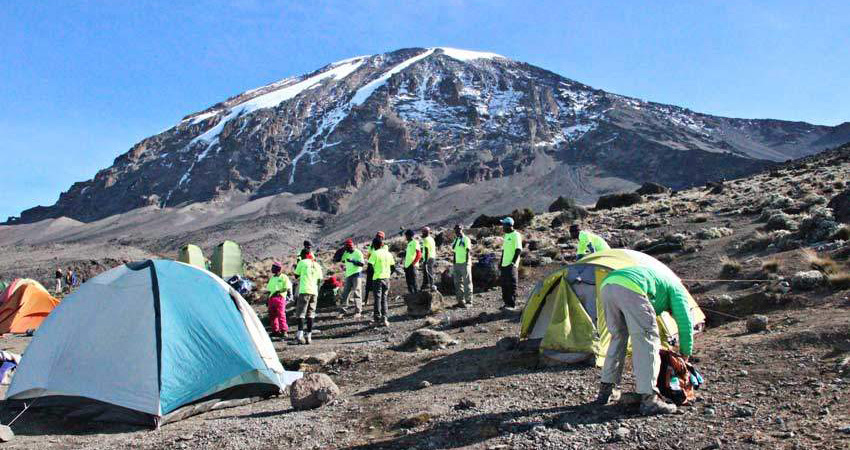
06 Day Mount Kilimanjaro Trekking Adventure + 2 nights Hotel Stay
The Machame route , commonly referred to as the “Whiskey route”, is one of the most popular routes on Kilimanjaro routes . Despite being a challenging climb compared to the Marangu route, the Machame route has one of the highest summit success rates landscape which allows climbers to “trek high and sleep low” hence making it a more favorable route for acclimatization.
Highlights
- Starts in Nairobi and Ends in Arusha /Moshi or back to Nairobi.
- Minimium 01 pax and Maximum 10 per group.
- Mountain Climbing Safari
- Summit Mount Kilimanjaro
- Breakfast, lunch, and dinner are included while on the mountain
- Services of porters,cook and guide
- 05 nights accommodation in tents on the mountain
- 02 nights hotel accommodation in Arusha on bed and breakfast.
Day 01 : Arusha (1400m) – Machame Gate (1828m) – Machame camp (3020m)
Hiking time: 7 hours
Distance: Approximately 10.8 km
Habitat: Montane forest
Your day starts early with breakfast, followed by a 45-minute drive from Moshi (910m) to the Machame Gate (1828m). The guides and porters prepare and pack the supplies and your equipment at the gate. After registering at the gate office, you start your ascent and enter the rain forest almost immediately. There is a strong possibility of rain in the forest, which will transform the trail into a very soggy, muddy and slippery experience. You will have a welcome lunch stop about halfway and will reach the Machame camp (3020m) in the late afternoon.
Your porters (arriving at the camp site long before you) will have erected your tent on arrival. In the evening the porters will bring a small bowl of washing water to your tent and the cook will prepare dinner, before you retire to your tent for the night. Night temperatures can already drop to freezing point at this campsite.
Day 02 : Machame camp (3020m) – Shira camp (3847m)
Hiking time: 6 hours
Distance: Approximately 5.2 km
Habitat: Moorland
You rise early at Machame camp and after breakfast you climb an hour or so to the top of the forest and then for 2 hours at a gentler gradient through the moorland zone. After a short lunch and rest, you continue up a rocky ridge onto the Shira plateau. By now you will be able to see in an easterly direction, the Western Breach with its stunning glaciers. You are now due west of Kibo and after a short hike you will reach the Shira campsite at 3 847m. The porters will once again supply you with a small bowl of washing water, before serving dinner. The night at this exposed camp will even be colder than the previous night, with temperatures dropping to well below freezing.
Day 03: Shira Camp (3847m) to Lava Tower (4642m) to Barranco camp (3984m)
Hiking time: 7 hours
Distance: Approximately 10.7 km
Habitat: Semi-desert
The route now turns east into a semi desert and rocky landscape surrounding Lava Tower, where you reach an altitude of 4642m after about a 5 hour trek. Lunch is served at a designated area. This is definitely the toughest day so far. It is normally around this point, where for the first time, some climbers will start experiencing symptoms of breathlessness, irritability and headaches. After lunch you descent again by almost 658m to the Barranco camping area.
After reaching the high altitude of 4600m at Lava Tower, the true acclimatisation benefit of this day becomes clear. This descent to Barranco camp takes about 2 hours and offers great opportunities to take some beautiful photographs of the Western Breach and Breach Wall. The camp is situated in a valley below the Breach and Great Barranco Wall, which should provide you with a memorable sunset while you wait for your dinner to be prepared.
Day 04: Barranco camp (3984m) – Barafu camp (4681m)
Hiking time: 8 hours
Distance: Approximately 9.4 km
Habitat: Alpine desert
After spending a night at the great Barranco Wall (a very imposing sight at first), you make your way up this awesome looking obstacle, which in the end usually turns out to be easier than anticipated. Topping out just below the Heim Glacier, you will now appreciate just how beautiful Mount Kilimanjaro really is. The route then heads down through the Karanga Valley over intervening ridges and valleys, and then joins up with the Mweka route. This is the preferred route down from the summit, so remember it. Turn left up the ridge and after another hour or so, you should reach Barafu Hut.
The last water stop on the route is the Karranga Valley, as there is no water available at Barafu camp. Barafu is the Swahili word for “ice” and it is a bleak and inhospitable camping area to spend the night. Totally exposed to the ever-present gales, the tents are pitched on a narrow, stony, and dangerous ridge. Make sure that you familiarise yourself with the terrain before dark to avoid any accidents.
The summit is now a further 1214m higher and you will commence with your final ascent attempt, the same night. Prepare your equipment, hiking poles and thermal clothing for your summit attempt. This should include the replacement of your headlamp and camera batteries and make sure you have a spare set available as well. To prevent freezing it will be wise to carry your water in a thermal flask. Go to bed at round about 19h00 and try to get some precious rest and sleep.
Day 05: – summit day Barafu camp (4681m)-Uhuru Peak (5895m)-Mweka (3090m)
Hiking time: 7 to 8 hours to reach Uhuru Peak, 6 to 8 hours to descend to Mweka Camp
Distance: Approximately 4.5 km ascent and 10.8 km descent
Habitat: Stone scree and ice-capped summit
You will get up around 23h20, and after some tea and biscuits you shuffle off into the night. You will head in a north-westerly direction and ascend through heavy scree towards Stella Point on the crater rim. For many climbers the 6-hour walk to Stella point is mentally and physically the most challenging on the route. At Stella Point (5739m) you will stop for a short rest and will be rewarded with the most magnificent sunrise you are ever likely to see (weather permitting). From Stella Point you will normally encounter snow all the way on your 2-hour ascent to Uhuru Peak. The time you will spend on the summit will depend on the weather conditions. Do not stop here for too long, as it will be extremely difficult to get going again due to cold and fatigue.
Enjoy your accomplishment and a day to remember for the rest of your life!
The walk back to Barafu from the summit, takes about 3 hours. Here you will have a well earned but short rest and collect the rest of your gear, before heading down to Mweka hut (3090m). The route is not difficult and will take you down the rock and scree path into the moorland and eventually into the forest. The camp is situated in the upper forest and mist or rain can be expected in the late afternoon. Dinner and washing water will be prepared.
Day 06 : Mweka camp (3090m) – Mweka Gate (1641m)
Hiking time: 4 to 6 hours
Distance: Approximately 8.5 km
Habitat: Forest
After an early and well-deserved breakfast, it is a short 4 to 6 hour and scenic hike back to the Park gate. Some hikers do experience knee problems which could make the descend longer than planned.
It is strongly recommended not to pay your porters any tips until you and all your gear have reached the gate safely.
At Mweka gate you will be issued with certificates of achievement .
From the Mweka Gate you will continue down into the Mweka village, normally a muddy 3 km (1 hour) hike. In the Mweka village you will be served a delicious hot lunch!! After lunch you drive back to Moshi for a long overdue hot shower, dinner and celebrations!!
Final Gear Checklist
One of the important prerequisites of a successful summit attempt is being properly equipped. Ensure that you are well equipped – print the Checklist below and mark it off, it will be an essential part of your preparation for the climb. Please remember to limit the weight of your duffel bag and its content, to be carried by the porters on the climb, to 15 kg (32 lbs.) or less. Extra luggage, including clean clothes to wear after your climb, can be left at the hotel in Moshi. Please feel free to contact us should you have any further questions regarding the checklist. We also provide a complete and quality rental service on all the equipment required on the mountain, as a sensible alternative to purchasing. Please click Gear Rental for more information.
Please note: This checklist is only a guideline. A comprehensive checklist will be send to you as soon as your hike is confirmed.
Make sure you have everything you need to help you successfully summit the Roof of Africa.
Travel Documents:
- Valid passport and visa
- Airline ticket
- International health card with immunizations (Yellow fever)
- Travel insurance
- Medical insurance
- US$ cash / Travellers Checks / Credit Card
Essential Items:
- Duffel bag – large enough for all climbing gear and clothing. To be carried by the porters. An extra bag to be left at the hotel with extra gear
- Small luggage lock – to lock zippers
- Day backpack – between 20 – 35 litres. Large enough to carry your water, camera, raincoat, lunch pack, snacks & warm clothing
- Sleeping bag
- Ski-pole / walking stick
- Water bottle / containers
- Kilimanjaro map (Can be bought at Park gate)
High Altitude Gear:
- Waterproof, breathable & windproof jacket (outer wear like Ventex, Gore-Tex or Jeantex)
- Waterproof, breathable & windproof pants (outer wear)
- Polar fleece (middle layer)
- Thermal underwear (under layers)
- Mittens or warm gloves
- Glove liners (if necessary)
- One pair thermal (polertex) socks
- Balaclava
- Gaiters
- Thermal water flask
Hiking Gear:
- Shorts
- Hiking pants
- Regular underwear
- T-shirts
- Raincoat or Poncho
Footwear:
- Water resistant semi-stiff hiking boots – mid weight boots work great
- Shoes for overnight camps – i.e. sneakers, running shoes, etc.
- Socks – several pairs for the climb
- Liner socks – to keep your feet dry and limit the risk of blisters
Equipment:
- Sun hat or similar (with a brim)
- Collapsible ski stick (optional but highly recommended)
- Water bottles – two or three (total capacity at least 4 litres)
- Head lamp, good strong one with spare batteries and an extra light bulb
- Water purification tablets
- Sunglasses, good quality dark lenses for the climb, with a securing strap
- Flashlight (torch) with spare batteries
Personal Items:
- Toilet kit (soap, tooth brush, toilet articles, wet wipes, etc.)
- Towel
- Sun screen and lip protection, SPF 30+
- Ziploc bags, to protect camera, binoculars, etc. from dust
- Toilet paper
- Money belt for passport and valuables
Medical and First Aid Supplies:
Headache tablets
Altitude sickness-Diamox (if not allergic to sulpha)
Diarrhoea – Imodium
Nausea – Valoid
Malaria – Prophylaxis
Water purification tablets
Painkillers
Muscular sprains
Abrasions blisters and cuts – Plaster, bandages
Antiseptic cream – Betadine
Flu and colds
Eye drops
Insect repellent
Optional Items
Camera, extra lenses and film (ASA 200 film recommended)
Binoculars
Powdered sports drinks for the climb (ex. Game or Isotonic drinks)
Pocket knife
Notebook & pencil
Plastic bags to keep clothing dry (masking tape)
Energy snacks and sweets




